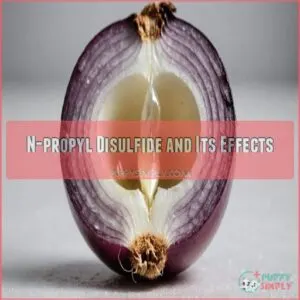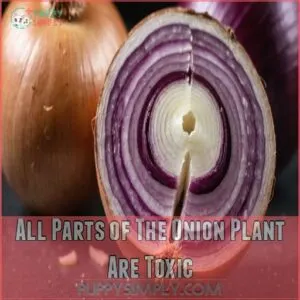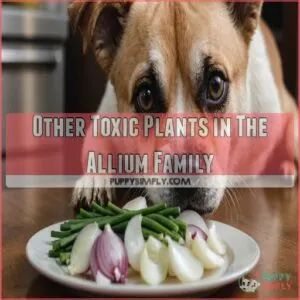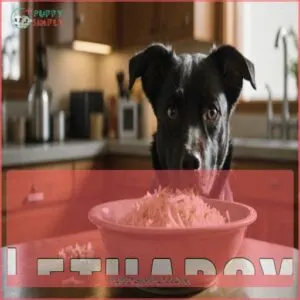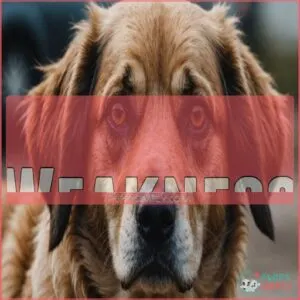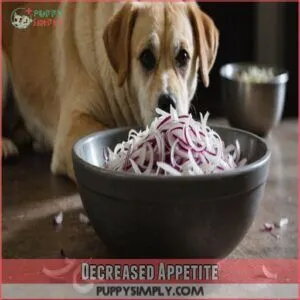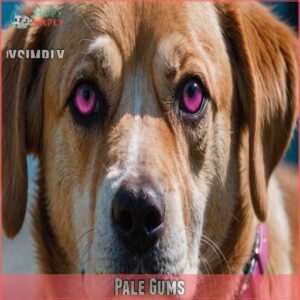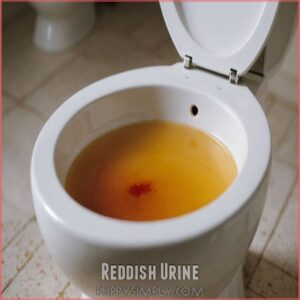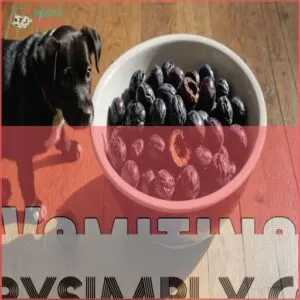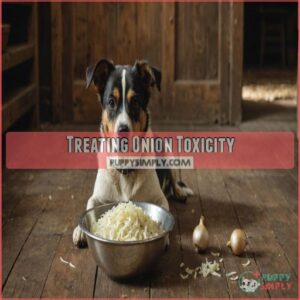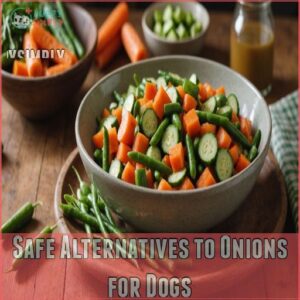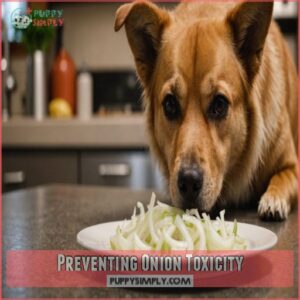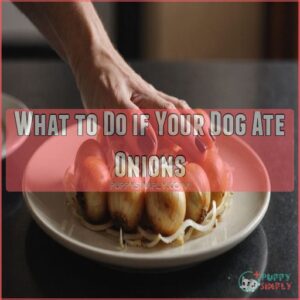This site is supported by our readers. We may earn a commission, at no cost to you, if you purchase through links.
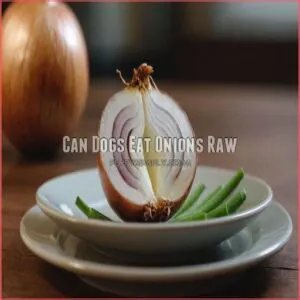
Even small amounts of onions contain N-propyl disulfide, which destroys your dog’s red blood cells and can lead to life-threatening anemia.
It doesn’t matter if they’re cooked, raw, powdered, or dried – all forms of onions are dangerous.
Just one medium onion can be fatal for a 45-pound dog.
If your pup has eaten onions, watch for symptoms like weakness, vomiting, and pale gums.
You’ll want to know exactly what steps to take if your furry friend gets into these forbidden vegetables.
Table Of Contents
- Key Takeaways
- Can Dogs Eat Onions Raw
- Risks of Onion Toxicity in Dogs
- Symptoms of Onion Toxicity
- Treating Onion Toxicity
- Safe Alternatives to Onions for Dogs
- Preventing Onion Toxicity
- What to Do if Your Dog Ate Onions
- Frequently Asked Questions (FAQs)
- Can dogs eat onions?
- Is it bad to eat a lot of onion?
- Can dogs eat onion rings?
- Can a 45 pound dog eat an onion?
- Are onions toxic to dogs?
- Can dogs eat mashed onions?
- What happens if my dog eats a little bit of onions?
- How much onion is toxic to a 10lb dog?
- Will one onion ring hurt my dog?
- Can dogs eat broth made with onions?
- How long after eating onions can symptoms appear?
- Are some dog breeds more sensitive to onions?
- Can onion-flavored foods affect dogs the same way?
- Will cooking destroy the toxic compounds in onions?
- Does size or age affect onion toxicity levels?
- Conclusion
Key Takeaways
- Don’t let your dog eat onions in any form – raw, cooked, or powdered onions contain N-propyl disulfide that destroys red blood cells and can be fatal.
- Watch for symptoms like weakness, vomiting, pale gums, and reddish urine if your dog eats onions, as they also contain N-propyl disulfide, similar to onion powder toxins, which can break down red blood cells – these signs indicate dangerous anemia that requires immediate veterinary care.
- You will need to contact your vet right away if your dog consumes onions – the amount eaten and timing are crucial details that help determine the best treatment plan.
- You can safely substitute onions with dog-friendly vegetables like carrots, cucumbers, and green beans that provide nutrition without risks.
Can Dogs Eat Onions Raw
Though it might seem harmless, giving your dog raw onions isn’t a good idea.
Onions, whether raw or cooked, are toxic to dogs and cats alike.
You’ve probably cooked with onions countless times, but for our furry friends, they’re a big no-no.
All parts of the onion plant—flesh, leaves, juice, and even the seemingly innocuous onion powder—pose serious dangers.
Even in small doses, onions can lead to serious health issues for your dog.
It’s important to keep onions and onion-based foods out of your pup’s reach and consider safe alternatives like carrots or green beans.
Stick to dog-safe foods and consult your vet to make sure your pet stays healthy and happy.
Risks of Onion Toxicity in Dogs
You may not realize it, but just like how feeding chorizo to dogs can be a potential health risk, onions can also pose serious health risks to your dog due to a toxin called N-propyl disulfide.
This compound, found in all parts of the onion plant, can damage your dog’s red blood cells and lead to anemia, making onions a dangerous addition to their diet.
N-propyl Disulfide and Its Effects
Watch out for onions in your dog’s diet!
They contain N-propyl disulfide, wreaking havoc on your pup’s red blood cells, leading to anemia.
This sneaky toxin is a major player in onion toxicity, making even small amounts risky, especially onion powders.
The allium family, including onions, garlic, and others, holds this danger, so steer clear for your furry friend’s safety.
All Parts of The Onion Plant Are Toxic
Imagine your dog’s health on the line because every part of the onion plant—flesh, leaves, and even juice—is toxic.
Onion powder is a potent danger, causing onion toxicity that damages red blood cells.
If you suspect onion poisoning, explore products and resources at Dog Onion Poisoning.
- Onion leaves: equally toxic
- Juice: hazardous
- Processed powder: more concentrated
- Red blood cell: destruction risk
- Strictly avoid: onions
Keep onions out of reach!
Other Toxic Plants in The Allium Family
It’s not just onions you need to worry about.
The whole allium family poses a threat to your furry friend.
Think garlic, chives, leeks, and shallots – they’re all toxic.
Even small amounts can cause problems, as a dog’s consumption of as little as 0.5% of their body weight in onions can lead to life-threatening anemia.
Here’s a quick guide:
| Plant | Toxicity Level | Symptoms | Safe Alternative |
|---|---|---|---|
| Onions | High | Anemia, vomiting, weakness | Carrots |
| Garlic | High | Similar to onions | Cucumbers |
| Chives | Moderate | Digestive upset, weakness | Green beans |
| Shallots | Moderate | Similar to chives | Celery |
Allium toxicity is serious; keep these plants away from your dog.
Symptoms of Onion Toxicity
When your dog consumes onions, signs of toxicity can pop up and be quite alarming. Watch for symptoms like lethargy, weakness, and decreased appetite, as these require prompt veterinary attention.
Lethargy
Lethargy in dogs, following onion ingestion, is like an invisible weight dragging their energy down.
This tiredness can signal onion-related anemia.
If you spot this sluggish behavior:
- Consult your vet immediately for a proper diagnosis.
- Monitor your pet’s energy levels and any additional symptoms.
- Prevent future incidents by keeping onions and related foods out of reach.
Weakness
Weakness in dogs, after an onion mishap, can leave even the bounciest pups feeling wiped out.
Picture your furry friend suddenly lacking their usual pep—it’s enough to make any owner fret.
Recognizing and tackling this weakness starts with a vet’s visit.
They’ll assess your dog’s red blood cells, giving you a clear game plan for recovery and preventing future slips.
Decreased Appetite
Feeling sluggish isn’t all that’s happening; your dog’s appetite might take a nosedive too.
This food aversion isn’t just upsetting but can clue you into onion toxicity.
Appetite loss causes stress, making dietary changes feel like a chore.
If Zeus skips meals, it’s time for a vet consultation.
This guarantees stress impact stays low, avoiding bigger health hiccups.
Pale Gums
Spotting pale gums in your dog can be an alarming experience.
This symptom hints at anemia caused by damaged red blood cells.
Keep an eye out for:
- Changed gum color: Pale vs. healthy pink
- Quick veterinary diagnosis: Essential for treatment
- Possible Heinz bodies presence: Observed in bloodwork
Recognizing these signs can make a pivotal difference in your pet’s health.
Fainting
Fainting in dogs from onion toxicity isn’t just a dramatic collapse; it’s a cry for help.
When red blood cells are compromised, oxygen doesn’t circulate well, causing dizzy spells and fainting.
If your furball faints, check for onion exposure ASAP.
For more information on supporting your dog during onion toxicity, see resources on Onion Dog Toxicity Products.
Here’s a quick reference:
| Symptom | Possible Cause | Action |
|---|---|---|
| Fainting | Anemia | Vet |
| Lethargy | Low oxygen | Monitor |
| Weakness | Cell damage | Supportive care |
| Pale Gums | Blood loss | Immediate care |
Understanding the causes of fainting and first aid can save the day.
Reddish Urine
Notice any unusually reddish urine?
This is a serious symptom of onion toxicity in dogs.
Reddish urine, along with pale gums, points to hemolytic anemia, where red blood cells are damaged.
This damage creates Heinz bodies, detectable through blood work.
Severe cases might need a blood transfusion.
Don’t delay; contact your vet immediately if you see this alarming urine color change.
Vomiting
Vomiting in dogs after onion ingestion isn’t just a hiccup; it’s a clear signal that something’s off.
If your furry friend starts retching, it’s a red flag for onion toxicity.
Dog vomiting can be distressing, but quick action is key.
Consult your vet for effective vomiting treatment and home remedies to help recovery.
Keep onions well out of paw’s reach!
Treating Onion Toxicity
If your dog eats onions, quick action is essential to prevent serious health issues, potentially including anemia.
Veterinarians may induce vomiting, provide supportive care, or even perform blood transfusions in severe cases.
Inducing Vomiting if Onions Were Recently Ingested
If your dog has chomped down on onions recently, inducing vomiting might be a lifesaver.
It’s a time-sensitive action–but don’t go all DIY without vet advice!
Reach out to your vet to discuss vomiting risks and safe home remedies.
They’ll guide you on exactly when to induce vomiting and when it’s best left to a professional.
Supportive Care Until Red Blood Cell Production Recovers
When your dog faces onion toxicity, supportive care is key.
Think of it as nurturing the fallen warriors—red blood cells.
This care includes monitoring your pup’s anemia treatment and ensuring nutritional support.
Keep an eye on recovery monitoring as red blood cell recovery time varies.
Patience is your ally; recovery might take a bit, but you’ve got this support covered.
Blood Transfusion in Severe Cases
Wondering how to handle severe onion toxicity in dogs?
Sometimes, a blood transfusion is necessary to treat hemolytic anemia.
This procedure can be very important if you’re aware that certain human foods like grape toxicity risks can harm your dog. This procedure can be very important if onion toxicity severity threatens your dog’s health.
Be aware of potential transfusion risks and costs.
Your vet will guide you through the transfusion procedure, ensuring your dog gets the safest care possible.
Safe Alternatives to Onions for Dogs
When considering healthy snacks for your furry friend, it’s also important to note that some human treats like cherries can be toxic due to cyanide in cherry pits. For keeping your dog safe, offering delicious alternatives like carrots, cucumbers, and green beans is a smart choice.
These nutritious vegetables, alongside other safe fruits and veggies, can easily satisfy your pet’s snack cravings without the risk associated with onions.
Carrots
So, your dog’s dodged a bullet—no onion poisoning!
Now, let’s talk carrots.
They’re a great, safe alternative.
Carrots for dogs offer a tasty and nutritious treat.
- They’re packed with vitamins.
- They help with dental health.
- They’re easy to prepare.
Remember to chop them into bite-sized pieces.
Too much of a good thing isn’t always good, so moderation is key!
Cucumbers
Cucumbers are a crunch-tastic treat for your dog, offering a hydrating snack that’s both low-calorie and easy to digest.
Packed with vitamins, they’re a cool alternative to onions.
Just slice them up and serve—no cooking required!
Cucumber benefits for dogs include keeping them cool and hydrated.
Keep portions small to guarantee safe snacking without tummy troubles.
Green Beans
Green beans are a fantastic, safe alternative for your pup. They’re not just crunchy vegetables; they’re like tiny, green superfoods packed with benefits, and as a nutritious snack, they can be incorporated into your dog’s diet in various ways, similar to other safe beans for dogs.
- Low in calories but still satisfying.
- High in fiber to aid digestion.
- Rich in vitamins A, C, and K.
- Contains iron for healthy blood.
- Easy to cook or serve raw.
Keep them plain and simple, without seasonings!
Other Fruits and Vegetables That Are Safe for Dogs
Beyond green beans, your pup can enjoy many safe fruits and veggies as healthy snacks.
Apples (minus seeds), blueberries, and watermelon offer sweet treats packed with vitamins.
Cooked sweet potatoes, pumpkin, and zucchini make excellent veggie options.
Just remember to introduce new foods gradually and in small portions.
Always wash produce thoroughly and remove any seeds or pits before serving to your four-legged friend.
Preventing Onion Toxicity
You’ll need to keep all onions and onion-containing foods stored safely away from your dog’s reach to prevent potentially fatal toxicity.
You should also carefully check ingredient labels on packaged foods and inform anyone who feeds your dog about the dangers of onions, as even small amounts can cause serious health problems.
Keeping Onions Out of Reach of Dogs
While you’ve got safe treats like carrots and cucumbers ready for your pup, it’s time to puppy-proof your kitchen from onions.
Store all onions, including powders and seasonings, in sealed containers inside closed cabinets.
Keep countertops clear of food prep items, and never leave grocery bags unattended.
A dedicated high shelf or locked pantry makes sure your furry friend stays safe from these toxic vegetables.
Avoiding Human Foods for Dogs
Pet parents often share their meals with their furry friends, but this habit can be dangerous.
Keep your kitchen a safe zone by avoiding table scraps and human snacks altogether.
Create a list of toxic foods, including onions, garlic, and other alliums, and post it on your fridge.
Stick to dog-specific treats and kibble to guarantee your pup’s safety.
Consulting a Veterinarian for Specific Recommendations
Your vet is your best partner in keeping your dog healthy and safe from onion toxicity.
They’ll provide personalized recommendations based on your dog’s age, size, and health status.
Here’s what to ask your vet:
- Which vegetables are safe for your specific dog’s needs
- How to properly portion treats and snacks
- What emergency steps to take if accidental onion ingestion occurs
They can also suggest onion-free treats that match your dog’s dietary requirements.
What to Do if Your Dog Ate Onions
If you’ve discovered your dog ate onions, don’t wait to see if symptoms develop – contact your veterinarian immediately for guidance.
You’ll need to share important details about the amount consumed and timing to help your vet determine the best course of action.
Contacting Your Veterinarian
If you suspect your dog ate onions, contact your veterinarian immediately – don’t wait for symptoms to appear.
Most vets provide 24/7 emergency services for situations like this.
They’ll need details about when the exposure occurred and your dog’s current symptoms.
Meanwhile, keep the ASPCA Animal Poison Control Center’s number (888-426-4435) handy as a backup resource for toxicity guidance.
Determining The Amount of Onion Consumed
Careful detective work is essential when figuring out onion toxicity.
Gather evidence by checking garbage bins, food containers, and countertops for remnants.
Note whether it was raw, cooked, or powdered onion, as potency varies.
As even a small amount of onions can be toxic, according to veterinarians can dogs eat onions and bell peppers.
Measure or estimate the amount – 100 grams per 20 kilograms of dog weight can be toxic.
Record when ingestion occurred, as this affects treatment options.
Monitoring Bloodwork if Recommended
Monitoring bloodwork reveals important details about your dog’s recovery from onion toxicity.
The vet will check for signs of anemia, damaged red blood cells, and Heinz bodies through regular blood tests.
These results help track the severity of toxicity and guide treatment decisions.
Understanding bloodwork markers helps determine if additional interventions, like blood transfusions, might be necessary during the healing process.
Following Treatment Recommendations From Your Veterinarian
Your veterinarian’s treatment plan is your roadmap to recovery.
They’ll outline specific medications, dosing schedules, and dietary restrictions customized to your dog’s condition.
Stick to their recommendations about food and water intake during recovery.
Don’t skip follow-up appointments – they’re essential for monitoring your pet’s progress.
Regular blood tests help track improvement, ensuring your dog bounces back safely from onion toxicity.
Frequently Asked Questions (FAQs)
Can dogs eat onions?
No, dogs can’t eat onions in any form – raw, cooked, or powdered.
They contain N-propyl disulfide, which is toxic and can cause severe anemia.
Even small amounts can be dangerous or fatal.
Is it bad to eat a lot of onion?
Onions, like garlic, damage red blood cells even in small amounts, which is also a concern for dogs eating human food items. Research shows eating more than one onion daily increases heart health risks.
While onions are nutritious, excessive consumption can cause digestive issues, bad breath, and blood sugar fluctuations.
Moderation’s key – stick to 1/2 onion daily.
Can dogs eat onion rings?
Onion rings, like other processed foods containing toxic spices and herbs, pose serious health risks for dogs.
The toxic compound N-propyl disulfide remains dangerous whether raw, fried, or cooked.
Keep all onion products away from your furry friend to prevent potentially fatal poisoning.
Can a 45 pound dog eat an onion?
Feeding your 45-pound dog any amount of onion can be dangerous and potentially fatal.
Even small amounts damage red blood cells, leading to anemia.
Keep all onion products away from your furry friend.
Are onions toxic to dogs?
Yes, all parts of onions are highly toxic to your dog.
They contain N-propyl disulfide that damages red blood cells, leading to anemia.
Even small amounts can be dangerous, so keep onions away from your pets.
Can dogs eat mashed onions?
Like a ticking time bomb in your pup’s bowl, mashed onions pack the same dangerous punch as raw ones.
They’ll damage your dog’s red blood cells, leading to potentially fatal anemia – don’t feed them.
What happens if my dog eats a little bit of onions?
Even small amounts of onions can cause toxic effects in your dog.
Watch for symptoms like lethargy, weakness, and pale gums.
If you notice these signs, contact your vet immediately for treatment.
How much onion is toxic to a 10lb dog?
Playing with fire is safer than feeding your dog onions.
For a 10lb dog, just 50 grams (half a medium onion) can be toxic.
That’s about 3 tablespoons of onion powder or 2 slices of raw onion.
Will one onion ring hurt my dog?
Yes, one onion ring can be harmful to your dog.
It doesn’t take much onion to cause toxicity – even small amounts can damage their red blood cells.
Call your vet immediately if they’ve eaten any.
Can dogs eat broth made with onions?
No matter how small the amount, broth made with onions can harm your dog like a silent poison.
The toxic compounds don’t cook away, so stick to onion-free broths for your furry friend.
How long after eating onions can symptoms appear?
Symptoms of onion toxicity in your dog can appear within 24 hours, but they might take up to 3-5 days to fully develop.
Watch for lethargy, pale gums, and weakness during this period.
Are some dog breeds more sensitive to onions?
While all dogs can suffer from onion toxicity, Japanese breeds like Akitas and Shiba Inus are genetically more sensitive to onion poisoning.
It’s best to keep onions away from all dogs regardless of breed.
Can onion-flavored foods affect dogs the same way?
Just one teaspoon of onion powder equals a whole onion’s toxicity.
Yes, onion-flavored foods can harm your dog because they often contain onion powder or extract, which is more concentrated than raw onions.
Will cooking destroy the toxic compounds in onions?
No, cooking doesn’t make onions safe for your dog.
The toxic compound N-propyl disulfide remains stable through any cooking method.
It’s best to keep all forms of onions away from your pets.
Does size or age affect onion toxicity levels?
Every single bite of onion can pack a powerful punch!
Your dog’s size and age dramatically impact toxicity – smaller or younger pups are hit harder, while bigger dogs can handle slightly more before showing symptoms.
Conclusion
While treats like carrots and cucumbers can make your pup’s tail wag, raw onions are absolutely off-limits.
Whether cooked or raw, onions pose a serious threat to your dog’s health.
Just one accidental bite could lead to dangerous complications.
Keep your kitchen safe by storing onions out of reach and choosing dog-friendly vegetables instead.
If you suspect your dog has eaten onions, don’t wait – contact your vet immediately. Your quick action could save your furry friend’s life.

